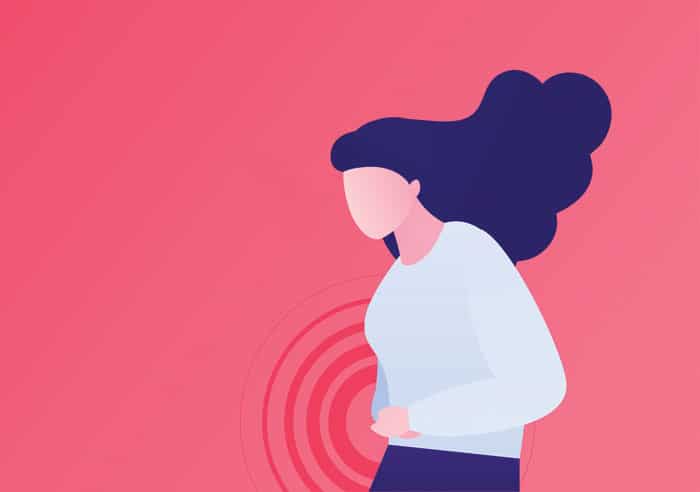 Anastasia Usenko/Getty Images
Anastasia Usenko/Getty Images It’s a sexy title for a film. The publicity image is also sexy. But there’s nothing sexy about the debilitating pain, isolation, and exhaustion that an estimated 10 percent of women experience each month from endometriosis.
Created and directed by Shannon Cohn, “Below the Belt,” which premiered at NYC’s Museum of Modern Art in May, explains this complex inflammatory disease through the lens of three patients. Cohn’s primary consultant on the film was Dr. Iris Orbuch, director of the Advanced Gynecologic Laparoscopy Center in Los Angeles. An interview with Dr. Orbuch follows.
1. How did you get involved with “Below the Belt”?
I have been passionate about raising awareness for a disease that afflicts roughly 200 million women worldwide since I stepped foot in the operating room as a first-year resident and watched my first endometriosis surgery. It was at that moment that I knew endometriosis is what I wanted to devote my life to.
Shannon Cohn and I joined forces roughly a decade ago. She’s a lawyer and film producer and I have the medical knowledge, which is a great combination in trying to tackle and undo medical teaching that looks at disease processes from a myopic lens. We both are dedicated to changing the narrative of this disease.
2. Can you please describe the disease?
Although endometriosis is commonly thought of as only menstrual pain, it is so much more. It is an inflammatory disorder that occurs as cells similar to the lining of the uterus are found outside of the uterus.
Symptoms include gastrointestinal (constipation, diarrhea, bloating); gynecological (painful periods, painful sex, heavy menstrual cycles, infertility); urological (urinary urgency, frequency or painful urination); fatigue and often back pain.
Some afflicted by the disease have one of these symptoms while others have many. I see many mother/daughters as well as siblings in my practice, and while one sibling may have more gastrointestinal symptoms, the other will have more gynecological symptoms.
5. How widespread is it — 1 in 10 girls?
Yes, roughly 10 percent: 200 million worldwide.
Those suffering see an average of eight physicians over a course of a decade until they are diagnosed.
6. Why is it so difficult for gynecologists to diagnose it?
Because of the multitude of symptoms that span across multiple organ systems, in addition to the fact that ultrasounds do not routinely pick up endometriosis (unless it is confined to the ovary), there is typically a diagnostic delay from symptom onset of roughly a decade. Those suffering see an average of eight physicians over a course of a decade until they are diagnosed.
Additionally, while I was a resident, I only learned about two appearances of endometriosis. In my first week of fellowship in Minimally Invasive Gynecological Surgery, I learned that endometriosis can appear black, blue, white, clear, red, yellow. So most gynecologists don’t recognize the various appearances of endometriosis. It’s sadly common that many patients who seek consultation with me have already had a laparoscopy by a gynecologist and were told that no endometriosis was found. I will often look at their surgical photos and show them all the endometriosis.
7. Why is it so difficult to treat?
Ninety-nine percent of gynecologists perform the wrong surgery, known as ablation, or burning of endometriosis. I learned how to do the wrong surgery while I was in my OB/GYN residency. Ablation only treats superficially while excision of endometriosis removes the entire lesion. One ablation surgery often begets a second and a third, and so on.
Excision surgery is the gold standard of treatment for endometriosis, but it’s technically difficult. l often have to excise lesions off the bowel, bladder, ureter, as well as other organs. It takes a lot of advanced surgical training. OB/GYN is a primary care field; general gynecologists are not learning how to do advanced surgery during their residency.
8. What happens if it goes undiagnosed?
Some who are afflicted with endometriosis and are asymptomatic only find out that they have it when they are having difficulty with fertility. In fact, endometriosis is the cause of 50 percent of unexplained infertility.
There is a complete lack of education about endometriosis even though the disease afflicts as many as those with diabetes.
9. Is there really a lack of education about this in medical schools?
Yes, there is a complete lack of education about endometriosis even though the disease afflicts as many as those with diabetes. We are trying to create a curriculum to educate medical students throughout the country about endometriosis.
When I first moved to Los Angeles in 2017, I began giving lectures entitled “Endometriosis: Hidden in Plain Sight” to not only gynecologists, but also pediatricians, family medicine practitioners, pelvic floor physical therapists — just about anyone who was willing to listen. It is so easy to diagnose if you know the right questions to ask.
10. Why is there a need for federal funding?
We don’t even have a blood test or an accurate way to diagnose endometriosis other than surgery. Those afflicted often are not living their best lives, and often have to go out on disability due to pain. So many healthcare dollars are wasted by repeat ablation surgeries. If patients were diagnosed at an early age and received excision surgery by a specialist as their first surgery, the trajectory of their lives would be drastically different.
11. Is it true that no period pain is normal?
I like to say if pain is causing you to reschedule plans, or schedule plans around your period, or if you withdraw from social activities or things that you love, that is too much.
12. Is there a genetic component?
Yes, there is a genetic component, however we have not identified the gene yet. We do know that if a mother, sibling, or aunt has endometriosis, this increases the likelihood the fetus will have it by 7 to ten fold, which means they are 70 to 100 percent likely to develop endometriosis.
13. What do you recommend to teens and young women who think they may have the disease?
Find a specialist. I approach endometriosis from a holistic mind-body, East-meets-West approach. Excision of endometriosis is the cornerstone of treatment, but I always recommend good gut health including auto-immune, organic, low inflammatory eating, healthy mind-body lifestyle habits, as well as other holistic approaches, which are listed in my book Beating Endo: How to Reclaim your Life from Endometriosis (Harper Collins, 2019).
There will be upcoming screenings of the film in London, Los Angeles, and Paris. Former Secretary of State Hillary Clinton is listed as an executive producer and former U.S. Senator Orrin Hatch was also involved.
Karen Lehrman Bloch is editor in chief of White Rose Magazine.






















 More news and opinions than at a Shabbat dinner, right in your inbox.
More news and opinions than at a Shabbat dinner, right in your inbox.